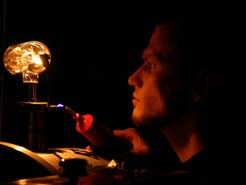Yes, sudden inspiration happens, even to me. Last Friday for example, I was sitting on the office, picking my nose with dedication, when it suddenly came to me: "Why not a low-pass?"
You see, I have had this problem with triggering. I want to measure the voltage between electrodes in the instant of breakdown - just when the plasma forms. This instant is reasonably short (breakdown happens in the order of nanoseconds if you are an electron, and microseconds for ions), so I need to tell my oscilloscope when to measure with some other method than pressing a button. This is commonly known as triggering, and I have been using the light from the discharge as a trigger. An optic fibre picks up the light, a photomultiplier converts it into an electric signal, and when this signal surpasses a certain level the oscilloscope measures the voltage for a couple of microseconds.
Unfortunately the light emitted by the plasma can be very faint. If I boost it to a sufficient level to trigger, the noise generated by the pesky cosmic radiation hitting my photomultiplier fools the oscilloscope into triggering at the wrong time, resulting in something like this:
The voltage is the friendly pink trace, and yellow represents the light (the lower it is the more light, because the PM has an inverted op-amp somewhere). As you can see, the scope triggered on a big spike - but if it were a real breakdown, then the light-trace would stay at a lower level afterwards as the plasma continues to burn.
So, why not a low-pass? A low-pass filter is an electronic circuit that only lets low frequencies pass - in its simplest form (which I used) it is implemented by an RC circuit.
I used an 1 Ohm resistance and a capacitor with 82 nanofarad. That gives the filter a cut-off frequency of around 2 MHz, or a rise-time of 550 nanoseconds. And the result?
Smoooth. (The little metal box on the lower left is the filter).
Of course, the filter does distort the signal a bit, but since I only use it for triggering, it does not matter. But to be sure, I overlaid the two signals to compare:
Th unfiltered light signal is in orange. It is a bit faster, but the difference is not big. If I ever want to use the signal itself, I'll whip up a Butterworth or Chebyshev filter with a steeper cut-off, but for now I am shiny.
I should have thought of that weeks ago though - a large part of my Master's Thesis was constructing band-stop filters for langmuir probes! Only I thought myself into a box trying to use the oscilloscopes smart-trigger functions to avoid the noise...
5 weeks ago





Great write-up.
ReplyDeleteIt's always nice to learn something new when someone else has a problem to solve then writes up their thought process and implementation.
I love it when inspiration hits. Good for you.
ReplyDeleteLooks like a winning notion.
Thanks!
ReplyDeleteIt truly seems to pan out as a great idea - if not in inventiveness, then in impact: Makes my life much easier, and my slave^H^H^H^H^H student is ecstatic!